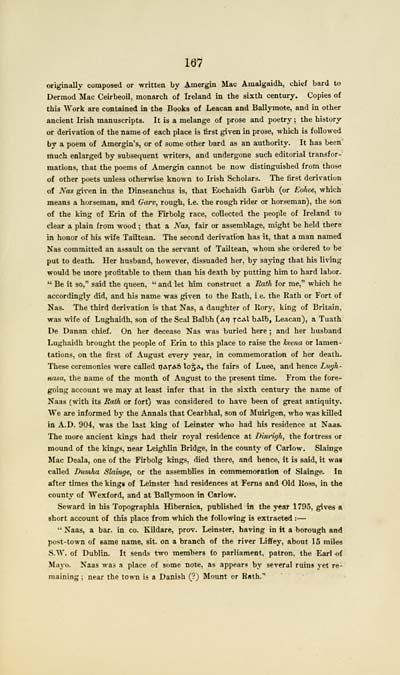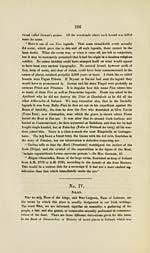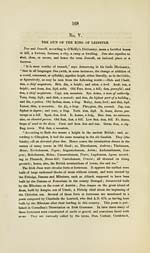Download files
Complete book:
Individual page:
Thumbnail gallery: Grid view | List view

167
originally composed or written by Amergin Mac Ainalgaidh, chief bard to
Dermod Mac Ceirbeoil, monarch of Ireland in the sixth century. Copies of
this Work are contained in the Books of Leacan and Ballymote, and in other
ancient Irish manuscripts. It is a melange of prose and poetry ; the history
or derivation of the name of each place is first given in prose, which is followed
by a poem of Amergin's, or of some other bard as an authority. It has been'
much enlarged by subsequent writers, and undergone such editorial transfor-
mations, that the poems of Amergin cannot be now distinguished from those
of other poets unless other'n-ise known to Irish Scholars. The first derivation
of \as given in the Dinseanchus is, that Eochaidh Garbh (or Eohee, which
means a horseman, and Garv, rough, i.e. the rough rider or horseman), the son
of the king of Erin of the Firbolg race, collected the people of Ireland to
clear a plain from wood ; that a Nas, fair or assemblage, might be held there
in honor of his vnle Tailtean. The second derivation has it, that a man named
Nas committed an assault on the servant of Tailtean, whom she ordered to be
put to death. Her husband, however, dissuaded her, by saj-ing that his living
would be more profitable to them than his death by putting him to hard labor.
" Be it so," said the queen, '• and let him construct a Rath for me," which he
accordingly did, and his name was given to the Rath, i e. the Rath or Fort of
Nas. The third derivation is that Nas, a daughter of Rory, king of Britain,
was wife of Lughaidh, son of the Seal Balbh (ai) r^^l bAlb, Leacan), a Tuath
De Danan chief. On her decease Nas was buried here ; and her husband
Lughaidh brought the people of Erin to this place to raise the keena or lamen-
tations, on the first of August every year, in commemoration of her death.
These ceremonies were called ijAfAó I05A, the fairs of Luee, and hence Liif/fi-
nasa, the name of the month of August to the present time. From the fore-
going account we may at least infer that in the sixth century the name of
Naas (with its Rath or fort) was considered to have been of great antiquity.
We are informed by the Annals that Cearbhal, son of Muirigen, who was killed
in A.D. 904, was the last king of Leinster who had his residence at Naas.
The more ancient kings had their royal residence at Dinrifjh, the fortress or
mound of the kings, near Leighlin Bridge, in the county of Carlow. Slainge
Mac Deala, one of the Firbolg kings, died there, and hence, it is said, it was
called Dumha Slainge, or the assemblies in commemoration of Slainge. In
after times the kingi of Leinster had residences at Ferns and Old Ross, in the
county of Wexford, and at Ballymoon in Carlow.
Seward in his Topographia Hibernica, published in the year 1795, gives a
short account of this place from which the following is extracted : —
" Naas, a bar. in co. Kildare, prov. Leinster, having in it a borough and
post-town of same name, sit. on a branch of the river Liffey, about 15 miles
S.W. of Dublin. It sends two members Co parliament, patron, the Earl of
Mayo. Naas was a place of some note, as appears by several ruins yet re-
maining ; near the town is a Danish (?) Mount or Rath."
originally composed or written by Amergin Mac Ainalgaidh, chief bard to
Dermod Mac Ceirbeoil, monarch of Ireland in the sixth century. Copies of
this Work are contained in the Books of Leacan and Ballymote, and in other
ancient Irish manuscripts. It is a melange of prose and poetry ; the history
or derivation of the name of each place is first given in prose, which is followed
by a poem of Amergin's, or of some other bard as an authority. It has been'
much enlarged by subsequent writers, and undergone such editorial transfor-
mations, that the poems of Amergin cannot be now distinguished from those
of other poets unless other'n-ise known to Irish Scholars. The first derivation
of \as given in the Dinseanchus is, that Eochaidh Garbh (or Eohee, which
means a horseman, and Garv, rough, i.e. the rough rider or horseman), the son
of the king of Erin of the Firbolg race, collected the people of Ireland to
clear a plain from wood ; that a Nas, fair or assemblage, might be held there
in honor of his vnle Tailtean. The second derivation has it, that a man named
Nas committed an assault on the servant of Tailtean, whom she ordered to be
put to death. Her husband, however, dissuaded her, by saj-ing that his living
would be more profitable to them than his death by putting him to hard labor.
" Be it so," said the queen, '• and let him construct a Rath for me," which he
accordingly did, and his name was given to the Rath, i e. the Rath or Fort of
Nas. The third derivation is that Nas, a daughter of Rory, king of Britain,
was wife of Lughaidh, son of the Seal Balbh (ai) r^^l bAlb, Leacan), a Tuath
De Danan chief. On her decease Nas was buried here ; and her husband
Lughaidh brought the people of Erin to this place to raise the keena or lamen-
tations, on the first of August every year, in commemoration of her death.
These ceremonies were called ijAfAó I05A, the fairs of Luee, and hence Liif/fi-
nasa, the name of the month of August to the present time. From the fore-
going account we may at least infer that in the sixth century the name of
Naas (with its Rath or fort) was considered to have been of great antiquity.
We are informed by the Annals that Cearbhal, son of Muirigen, who was killed
in A.D. 904, was the last king of Leinster who had his residence at Naas.
The more ancient kings had their royal residence at Dinrifjh, the fortress or
mound of the kings, near Leighlin Bridge, in the county of Carlow. Slainge
Mac Deala, one of the Firbolg kings, died there, and hence, it is said, it was
called Dumha Slainge, or the assemblies in commemoration of Slainge. In
after times the kingi of Leinster had residences at Ferns and Old Ross, in the
county of Wexford, and at Ballymoon in Carlow.
Seward in his Topographia Hibernica, published in the year 1795, gives a
short account of this place from which the following is extracted : —
" Naas, a bar. in co. Kildare, prov. Leinster, having in it a borough and
post-town of same name, sit. on a branch of the river Liffey, about 15 miles
S.W. of Dublin. It sends two members Co parliament, patron, the Earl of
Mayo. Naas was a place of some note, as appears by several ruins yet re-
maining ; near the town is a Danish (?) Mount or Rath."
Set display mode to: Large image | Transcription
Images and transcriptions on this page, including medium image downloads, may be used under the Creative Commons Attribution 4.0 International Licence unless otherwise stated. ![]()
| Early Gaelic Book Collections > J. F. Campbell Collection > Transactions of the Ossianic Society > Volume 5 > (207) |
|---|
| Permanent URL | https://digital.nls.uk/82284293 |
|---|
| Description | Dublin : Printed under the direction of the Council, 1854-1861. |
|---|---|
| Shelfmark | Cam.1.c.5-10 |
| Additional NLS resources: | |
| Description | Volumes from a collection of 610 books rich in Highland folklore, Ossianic literature and other Celtic subjects. Many of the books annotated by John Francis Campbell of Islay, who assembled the collection. |
|---|
| Description | Selected items from five 'Special and Named Printed Collections'. Includes books in Gaelic and other Celtic languages, works about the Gaels, their languages, literature, culture and history. |
|---|

